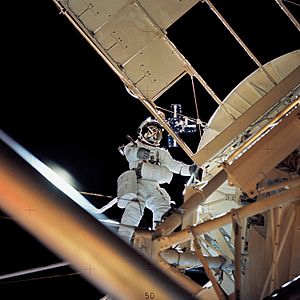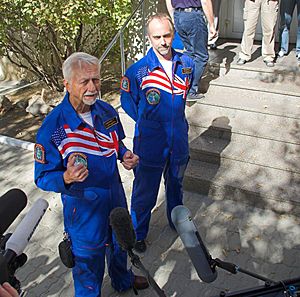Owen Garriott facts for kids
Quick facts for kids
Owen Garriott
|
|
|---|---|

Garriott in 1971
|
|
| Born |
Owen Kay Garriott
November 22, 1930 Enid, Oklahoma, U.S.
|
| Died | April 15, 2019 (aged 88) Huntsville, Alabama, U.S.
|
| Alma mater | University of Oklahoma (BS) Stanford University (MS, PhD) |
| Occupation | Engineer |
| Awards | NASA Distinguished Service Medal |
| Space career | |
| NASA astronaut | |
|
Time in space
|
69d 18h 56m |
| Selection | 1965 NASA Group 4 |
|
Total EVAs
|
3 |
|
Total EVA time
|
13 hours 43 minutes |
| Missions | Skylab 3, STS-9 |
|
Mission insignia
|
  |
| Retirement | June 1986 |
| Scientific career | |
| Thesis | The determination of ionospheric electron content and distribution from satellite observations. (1959) |
| Doctoral advisor | Oswald G. Villard, Jr. Allen M. Peterson |
| Doctoral students | Aldo da Rosa |
Owen Kay Garriott (born November 22, 1930 – died April 15, 2019) was an American electrical engineer and NASA astronaut. He spent a total of 69 days in space on two important missions. In 1973, he lived for 60 days on the Skylab space station during the Skylab 3 mission. Ten years later, in 1983, he flew for 10 days on the Space Shuttle mission Spacelab-1.
Before becoming an astronaut, Garriott served in the United States Navy. He was also an engineering professor at Stanford University. After his time at NASA, he continued to work in space-related fields. He also studied tiny living things, called microbes, found in extreme places on Earth.
Contents
Early Life and Education
Owen Kay Garriott was born in Enid, Oklahoma, on November 22, 1930. His parents were Owen and Mary Catherine Garriott. As a boy, he was a Boy Scout and earned the rank of Star Scout.
He graduated from Enid High School in 1948. He was very popular and was voted "Most Likely To Succeed." Owen went on to study at the University of Oklahoma, where he earned a degree in electrical engineering in 1953. Later, he earned his master's and Ph.D. degrees in electrical engineering from Stanford University.
Career Highlights
Military Service and Teaching
From 1953 to 1956, Garriott worked as an electronics officer in the United States Navy. After that, he became a professor of electrical engineering at Stanford University. He taught and did research on how the Earth's upper atmosphere works. He wrote many scientific papers about his findings.
In 1966, he completed a special pilot training program with the United States Air Force. This helped him learn to fly jet aircraft, which was important for his future as an astronaut.
Becoming a NASA Astronaut
In 1965, NASA chose Owen Garriott as one of only six scientist-astronauts. This was a very special group of people who were both scientists and trained astronauts.
Skylab 3 Mission

Garriott's first trip to space was on the Skylab 3 mission in 1973. This mission set a new world record for how long people could stay in space, lasting about 60 days! During this time, the astronauts did many experiments. They studied the Sun, looked at Earth's resources, and learned how humans adapt to living in weightlessness.
STS-9 Spacelab-1 Mission
His second space mission was aboard STS-9 (Spacelab-1) in 1983. This mission lasted 10 days on the Space Shuttle Columbia. It was a very important mission because it showed that the Spacelab module could be used for many different types of scientific research in space.
Garriott was also an amateur radio operator. On this mission, he made history by setting up the first amateur radio station in space. On December 1, 1983, he made the first radio contact from space using a small handheld radio. This led to many other astronauts and cosmonauts using amateur radio in space, even on the International Space Station today!
The Skylab "Stowaway" Prank
During the Skylab 3 mission, Owen Garriott played a fun prank on the ground control team in Houston. On September 10, 1973, controllers heard a woman's voice coming from Skylab! The voice called out to the capsule communicator (CAPCOM), Bob Crippen, by name. She then said she had brought a home-cooked meal for the astronauts. She even described seeing forest fires and beautiful sunrises from space.
After a few minutes, she said, "Oh oh. I have to cut off now. I think the boys are floating up here toward the command module and I'm not supposed to be talking to you." It turned out that Garriott had secretly recorded his wife, Helen, during a private radio call the night before. He then played the recording to surprise everyone!
After NASA
After leaving NASA in 1986, Garriott continued to work in the aerospace field. He advised many companies and served on important committees for NASA.
He also became a professor at the University of Alabama in Huntsville. There, he studied new microbes (tiny living things) that he found in extreme places. These included very alkaline lakes and deep-sea hydrothermal vents near the Azores in the Atlantic Ocean. He even went on trips to Antarctica and brought back meteorites for study.
Family Life
Owen Garriott married his high school sweetheart, Helen Mary Walker, in 1952. They had four children: Randall, Robert, Richard, and Linda. His son, Richard Garriott, became a famous computer programmer who created the Ultima computer game series.
In 2008, Richard Garriott became the first American to follow his parent into space as a space tourist. Owen Garriott was there in Kazakhstan to watch his son's launch and return.
Owen Garriott passed away on April 15, 2019, at his home in Huntsville, Alabama.
Awards and Recognition
Owen Garriott received many awards and honors throughout his life:
- National Science Foundation Fellowship (1960–1961)
- Honorary Doctorate of Science from Phillips University (1973)
- NASA Distinguished Service Medal (1973)
- Fédération Aéronautique Internationale V. M. Komarov Diploma (1973)
- Octave Chanute Award (1975)
- NASA Space Flight Medal (1983)
The three Skylab astronaut crews, including Garriott, won the 1973 Collier Trophy. This award recognized their important work in space exploration. He was also inducted into several Halls of Fame, including the United States Astronaut Hall of Fame in 1997.
A street in his hometown of Enid, Oklahoma, is named after him.
Books
Garriott helped write several books. He was a co-author of Homesteading Space, which tells the history of the Skylab program. He also co-authored Introduction to Ionospheric Physics. He contributed to the book NASA's Scientist-Astronauts and wrote its foreword.
Images for kids
-
Garriott using an amateur radio during STS-9 training in 1983
See also
 In Spanish: Owen Garriott para niños
In Spanish: Owen Garriott para niños



